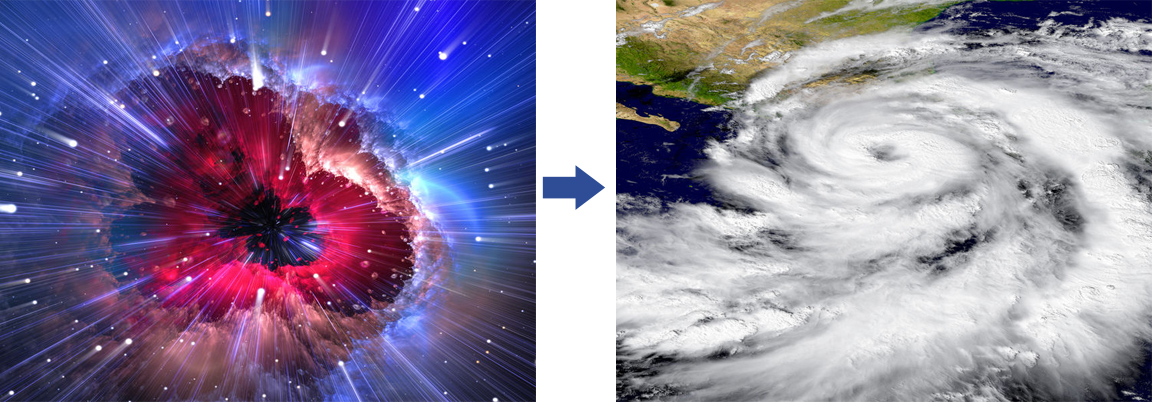From the Big Bang to Hurricanes
by Way of Physics

Among the elements that contribute to the destiny of the world,
order and disorder play a predominant role.
Principle of Least Action
Classical mechanics, which is rooted in the concept of order, allows us to describe the movement of astronomical objects and physical bodies. In Galileo’s and Newton’s laws, reversibility is possible since friction is neglected. One can travel from the past to the future or from the future to the past with the same ease. We say that the laws of classical mechanics are symmetrical.
In a fluid system at rest, for example, everything appears calm, and yet billions of billions of molecules are constantly jostling on a microscopic level, though it is not visible to our macroscopic world. If, by chance, the initial equilibrium were to be modified slightly, the modification would cause a movement we call wind. In this example, which features near-equilibrium, we can in an initial approximation ignore any irreversibility and apply the laws of classical mechanics, since order is more or less assured.
The example can be summarized by the principle of least action, which states that nature seeks the path of least resistance.
With the birth of thermodynamics, our macroscopic world was suddenly portrayed as a subtle blend of both order and disorder. Energy was conserved but degraded. This disorder was explained by the unpopular second law of thermodynamics. Entropy, the new name for disorder, measured the degradation caused by irreversibilities of all kinds. The symmetry of the laws of physics is disproven. With the advent of entropy came time, which flowed only toward the future, dooming us all to age.
Then Ludwig Boltzmann began searching for the foundations of thermodynamics in the world of molecules, drawing on statistical physics and probability theory. He was able to describe transport phenomena and thus link entropy to molecular disorder. Furthermore, in the 1970s, chaos theory specialists showed that order can appear locally in a system whose initial equilibrium is disrupted and tends toward disorder. The only condition is that, on the whole, disorder increases in accordance with the second law of thermodynamics.
Principle of Worst Action
Self-organized structures created out of such extreme disequilibrium were called dissipative structures by Ilya Prigogine to encompass both notions of order and disorder.
Such structures are sometimes unacceptable because the order introduced into a dissipative system prevents it from quickly reaching its final point of equilibrium. Some types of highly dangerous dissipative structures include:
– Supersonic jets in valves, whose instabilities cause power plants to vibrate
– Hurricanes, which wreak havoc on the world and are the result of an excessive imbalance in nature
To avoid such harmful dissipative structures, we needed the principle of worst action, which eliminates any order that forms in systems where massive amounts of energy must degrade rapidly. It makes it possible to shorten the lifespan of dangerous structures. The principle of worst action lay in direct opposition to the principle of least action—hence its name.
This haunting question of order and disorder, good and evil, seems like a knotty one and has been the subject of enormous philosophical and metaphysical discussion, much of it immensely obscure. Derived from physics, the principle of worst action may at first glance appear to add fuel to the fiery debate, but surprisingly it sheds light on it instead. The objective of this website is to try to show how.
